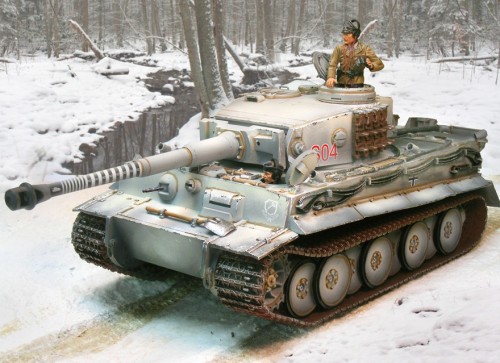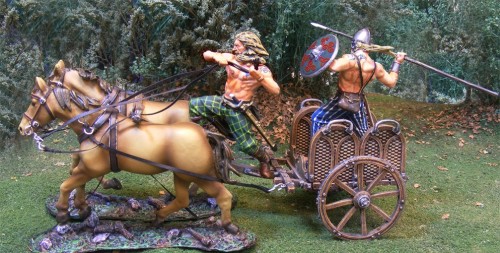There were never very many Tiger tanks, less than 1,400 total. They were huge (German crews scornfully called them “furniture vans”), high maintenance, a gas-guzzler even by tank standards, and were more often out of commission due to mechanical failure than damage in combat. And, after its North African debut in a battle near Robaa, Tunisia, a Feb. 5th, 1943, New York Times article stated the Tiger “failed to impress military observers here.” According to those observers “a few well-placed shots even from a light anti-tank rifle” could immobilize it. That article for home consumption literally papered over the truth. Allied troops were scared to death of the Tiger.

There was one very good reason for that fear: they didn’t have a weapon powerful enough to stop it. The reasons for that boiled down to differences in tank doctrine and philosophy based on tradition, prejudice, and circumstance. Despite a World War I flirtation with (other countries’) tanks, in practical terms the US Army was a latecomer to tank warfare, not fielding a mechanized armor corps until 1940, and was prejudicially influenced by horse cavalry advocates led by Chief of Cavalry Maj. Gen. John K. Herr (whose office was not disbanded until 1942). As such, though Army armor advocates studied writings by armored warfare philosopher Gen. Heinz Guderian and others as well as the Wehrmacht’s blitzkrieg battlefield successes, American armor advocates took away only that part of German tank doctrine that suited them: mass, speed, and maneuver. Accordingly, the American role of tanks was not to fight other tanks, but to smash through enemy lines and raise hell in their rear, the traditional role of cavalry.

Overlooked or ignored was the other side of the coin of German blitzkrieg tank doctrine expressed in Guderian’s 1937 book Achtung Panzer!, “The tank’s most dangerous enemy is another tank [emphasis added]. If we are unable to defeat the enemy armor the breakthrough has as good as failed. . . .” The Tiger was the ultimate expression of that tank versus tank doctrine.
To Guderian’s disgust, the Tigers first saw action in the siege of Leningrad. In his book Panzer Leader, Guderian wrote, “[Hitler] ordered that the Tigers be committed in a quite secondary operation, in a limited attack carried out in [swampy, forested] terrain that was utterly unsuitable. . . . The results were not only heavy, unnecessary casualties, but also the loss of secrecy and of the element of surprise for future operations.”

The heavy tank battalion s.Pz.-Abt. 501(Schwere Panzer-Abteilung 501) began arriving in Tunis in late November 1942. Kampfgruppe Lueder (named after its leader Maj. Hans-Georg Lueder), initially three Tigers and four Panzer IIIs, later three more Tigers, went into action on Dec. 1, 1942, participating in the Battle of Tebourba. When the battle ended in a German victory on Dec. 5, Allied troops under British Lt. Gen. Kenneth Anderson had lost 55 tanks, hundreds of vehicles, and more than 1,000 troops captured, with the Tigers knocking out most of the Allied tanks.
Soon the sight of even one Tiger entering battle caused the blood in Allied troops to run cold. The Tiger’s high-velocity 88 mm main gun could outshoot anything they had, and armor piercing shells bounced off the Tiger’s thick armor – even from ranges as close as 50 meters. In an attack against Allied positions in the Medjerda river valley of northwest Tunisia not long after, s.Pz.-Abt. 501 reported that “fleeing enemy columns and tanks were observed as soon as the Tigers appeared.”

Over time, the fearsome and intimidating reputation of the Tiger grew to mythic proportions. Maj. Christopher W. Wilbeck noted in his study of German heavy tank battalions that whenever a German tank appeared, regardless of type, “Among the Allied armies, units continually reported that Tiger tanks were in their sector or that they had destroyed Tiger tanks.”

Though destroying a Tiger was high-risk bordering on suicide early in the war, disabling one was not. The Allies’ most successful anti-Tiger tactic in Tunisia was a retrograde maneuver, laying anti-tank mines guarded by antitank guns. When a Tiger was immobilized by a mine, antitank guns could take it under fire, or artillery fire was called in. Later in France, tactical air – fighter-bombers using rockets and bombs – proved the most effective countermeasure. In March 1943, s.Pz.-Abt. 501 was succeeded by s.Pz.-Abt. 504. During the two months it operated in Tunisia before the surrender of all Axis troops in Tunisia, s.Pz.-Abt. 504 destroyed more than 150 enemy tanks and had a kill ratio of 18.8 enemy tanks for every Tiger lost. (courtesy Defensemedianetwork.com)
“Alwin”, Forces of Valor’s second 1:32 scale Tiger I heavy tank looks to churn up the North African desert some time in April.





